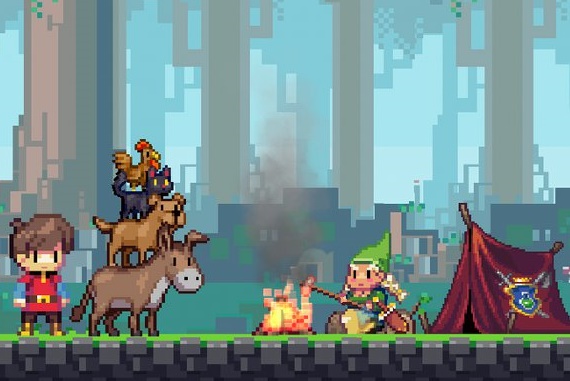Pixels were the original fundamental building blocks of games until crazy things like voxels and polygons came around. But why use pixels now? Is it to tap into people’s nostalgia for a simpler period of gaming? Or by this point is it an artistic choice? The Adventures of Pip certainly argues for the latter, presenting us with a vision of what a pixel game might look like now if nothing else had replaced the style.
There exists a world in which the rich and the wealthy are not so because of money, but instead because they own more pixels. Having more pixels than the person next to you allows you to display yourself at higher resolutions making you look fantastic and clear for everyone to see. Enter your main character Pip. He’s one of the poorest of the poor and he’s got nothing more than one pixel to his name! Why is this important? Because an evil queen just captured a princess that can make or destroy pixels at will and is de-resolutionising everyone in the kingdom. But that’s not a big deal for our hero Pip, as he has no pixels in the first place, and off he goes to save the kingdom.
Starting off as nothing more than a red square (a pixel), Pip sets out from the castle. From there the various environments offer a range of different challenges that require a bit of thought to make it through. While it’s not the most mind-bendingly difficult game, it does offer plenty of retro-style action. Where this game breaks away from the classics it pays homage to is after our hero comes across the grave of a past hero and the ghost tells our little boxxy friend that he’s going to need a few more pixels if he’s to make it anywhere. Luckily for Pip, he is then gifted the power of the bitstream, allowing him to transform himself into a person capable of wall jumping, ledge holding, and punching enemies and certain obstacles out of his way. But while transforming into a person grants a decent amount of versatility, it does have a certain amount of drawbacks.
Being a block has the simplicity of being tiny and easier to move through smaller places. When adding the laws of gravity to the equation, Pip is much lighter allowing him to bounce much higher than he would otherwise with things like appendages to weigh him down. From human form, it’s easy for Pip to shed the extra resolution and scale himself back down. But the bitstream is a finite resource, and needs to be used sparingly, because taking actions as human Pip will use the pixels up. To replenish this resource, Pip needs to absorb the pixels of a nearby enemy. Thankfully the game is generous enough that it’s possible to find these enemies around when they’re needed.
Sadly there’s not too much more to the game than that. Adventures of Pip is a solid platformer with a clever little gameplay mechanic, but ultimately doesn’t do all that much with it. That being said, away from the mechanics, it was also good to see one of these retro-themed platformers do something more with the art style than simply have it as window-dressing. Adventures of Pip actually turns pixels into part of the gameplay, and that’s neat.
– Pierre-Yves L.
Contributor








